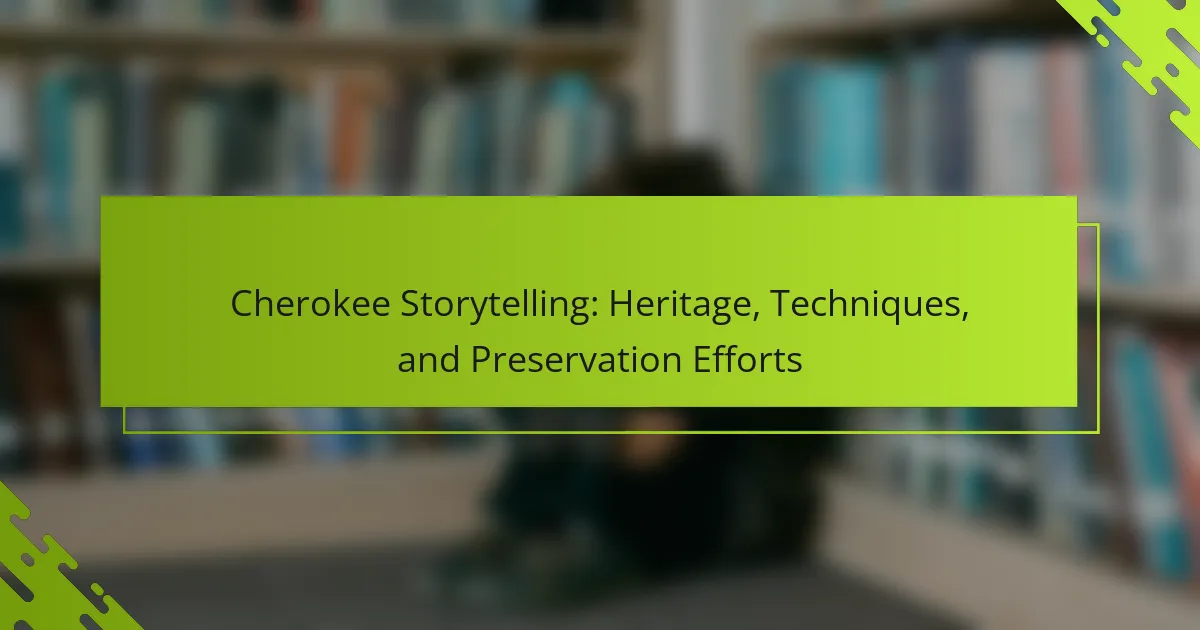Cherokee storytelling is vital for cultural preservation and community bonding. This article explores its heritage, key techniques, and ongoing efforts to sustain these traditions. We will examine the significance of oral narratives, the role of elders, and modern initiatives that engage younger generations. Understanding these aspects fosters appreciation for Cherokee values and history.
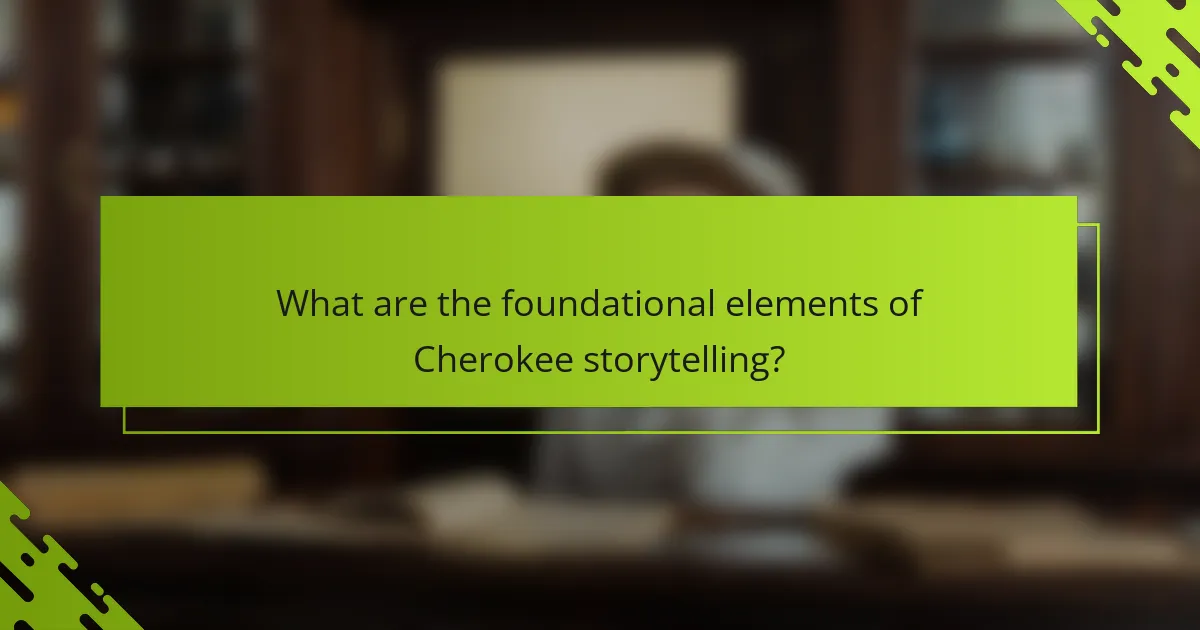
What are the foundational elements of Cherokee storytelling?
Cherokee storytelling relies on oral tradition, cultural values, and community engagement. Key elements include the use of animals as characters, moral lessons, and the integration of historical events. These stories often reflect the Cherokee worldview, emphasizing harmony with nature and the importance of relationships. Techniques such as repetition and vivid imagery enhance the storytelling experience, making it memorable and impactful. Preservation efforts focus on teaching younger generations and documenting stories to maintain cultural heritage.
How do oral traditions shape Cherokee culture?
Oral traditions profoundly shape Cherokee culture by preserving history, values, and identity through storytelling. These narratives are vital for teaching moral lessons and cultural practices. Storytelling techniques include the use of vivid imagery and communal participation, enhancing engagement and memory retention. Preservation efforts focus on revitalizing language and storytelling practices among younger generations, ensuring cultural continuity.
What themes are prevalent in Cherokee narratives?
Cherokee narratives often explore themes of nature, spirituality, community, and moral lessons. These stories serve to preserve cultural identity and impart wisdom across generations. Nature is frequently depicted as a vital force, reflecting the interconnectedness of all living things. Spirituality is woven into narratives, illustrating the importance of harmony with the universe. Community themes emphasize cooperation and shared values, reinforcing social bonds. Moral lessons guide behavior and decision-making, ensuring cultural teachings endure.
Which storytelling techniques are commonly used?
Cherokee storytelling commonly uses techniques such as oral tradition, symbolism, and communal participation. These methods preserve cultural heritage and convey moral lessons. Oral tradition allows stories to adapt over generations, while symbolism enriches narratives with deeper meanings. Communal participation fosters a collective experience, reinforcing community bonds.
How do environmental factors influence storytelling styles?
Environmental factors significantly shape Cherokee storytelling styles by influencing themes, techniques, and preservation methods. The natural landscape and cultural heritage provide a rich backdrop for narratives, emphasizing interconnectedness with nature. Oral traditions adapt to regional elements, such as flora and fauna, which enhances relatability and resonance. Community gatherings and seasonal events also play a crucial role, fostering collective storytelling experiences that reinforce cultural identity. These practices ensure the transmission of knowledge and values across generations, preserving the unique attributes of Cherokee heritage.
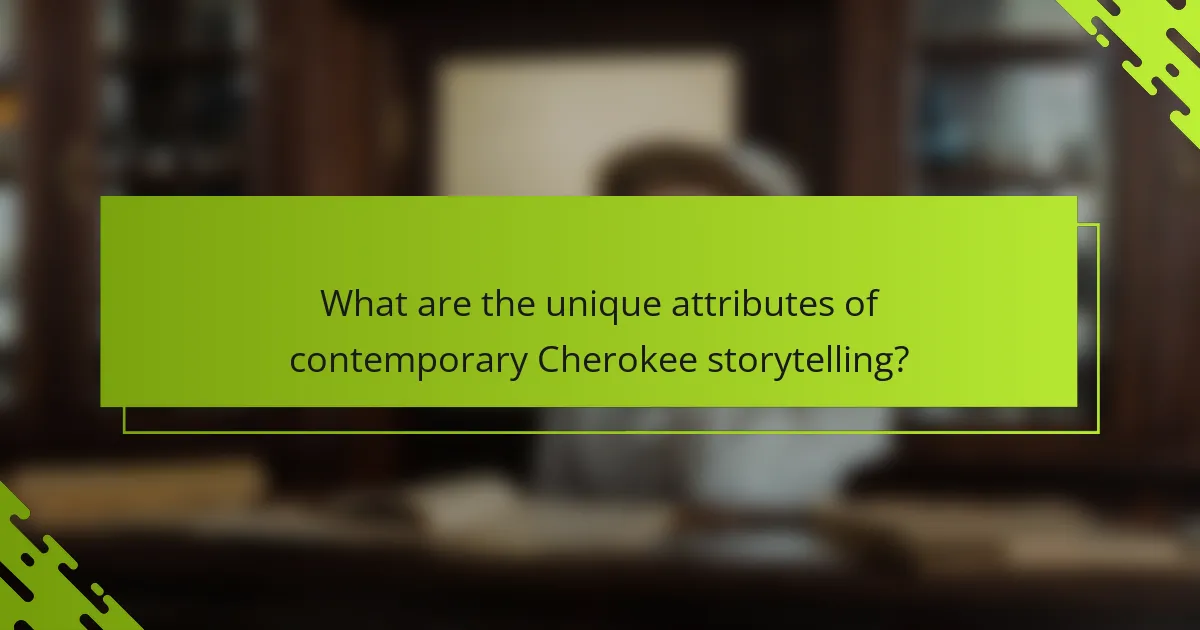
What are the unique attributes of contemporary Cherokee storytelling?
Contemporary Cherokee storytelling features unique attributes that include deep cultural significance, oral traditions, and community engagement. These stories often incorporate lessons, moral teachings, and historical context, reflecting the tribe’s values and beliefs. Unique attributes also include the use of traditional language and symbolism, which enhance the richness of the narratives. Additionally, storytelling serves as a means of preserving heritage and fostering identity within the Cherokee community.
How have modern influences altered traditional narratives?
Modern influences have diversified Cherokee storytelling, integrating contemporary themes while preserving traditional elements. This evolution reflects a blend of oral traditions and modern media, enhancing accessibility and relevance. For instance, digital platforms allow wider dissemination of stories, attracting younger audiences. Additionally, collaborations with artists and writers introduce fresh narratives, yet core values and cultural teachings remain intact. This dynamic interplay ensures that Cherokee storytelling continues to thrive in a changing cultural landscape.
Which mediums are now utilized in storytelling?
Cherokee storytelling utilizes various mediums, including oral traditions, written texts, visual art, and digital platforms. Oral storytelling remains the core method, preserving cultural narratives through spoken word. Written texts document stories for future generations, while visual art enhances storytelling with imagery. Digital platforms expand reach, allowing storytelling to transcend geographical boundaries.
What role do community gatherings play in storytelling today?
Community gatherings are vital for Cherokee storytelling, fostering cultural continuity and engagement. These events allow individuals to share narratives that preserve heritage and teach younger generations. Storytelling at gatherings strengthens community bonds and encourages the transmission of traditional techniques. Furthermore, they provide a platform for discussing preservation efforts, ensuring that unique stories remain relevant in contemporary society. Through these interactions, the community reinforces its identity and values, adapting stories while honoring ancestral traditions.
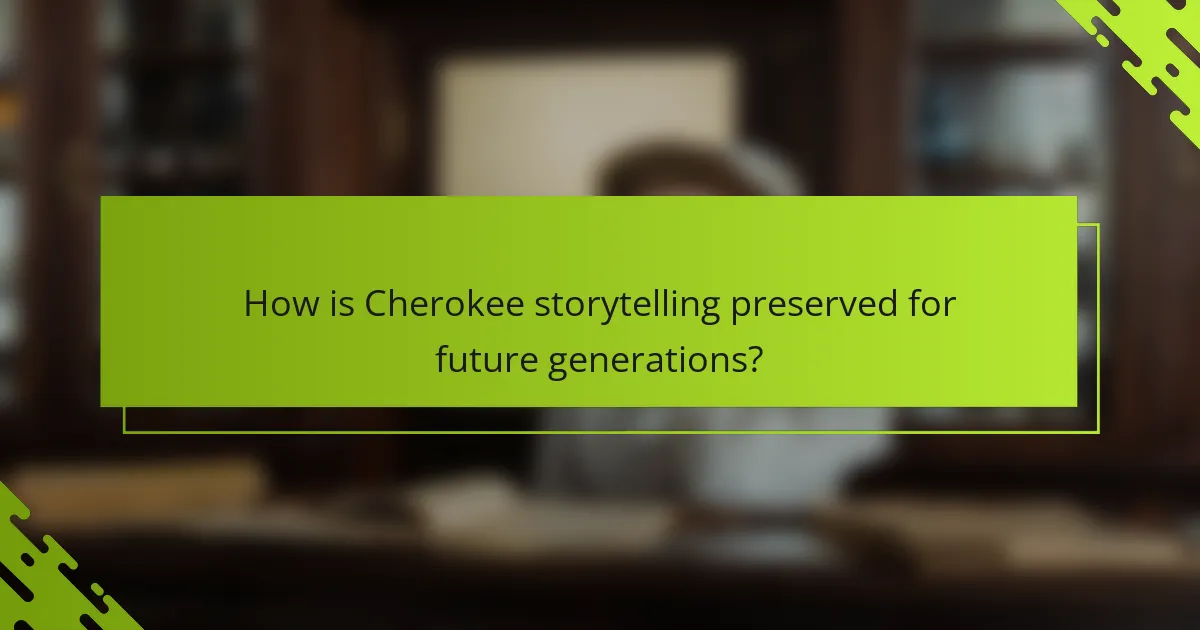
How is Cherokee storytelling preserved for future generations?
Cherokee storytelling is preserved through oral traditions, community involvement, and educational initiatives. Elders play a crucial role by sharing stories that convey cultural values and history. Storytelling workshops and festivals further engage younger generations, ensuring the continuation of these traditions. Additionally, digital media is increasingly utilized to document and disseminate Cherokee narratives, making them accessible to a wider audience.
What initiatives are in place to support storytelling education?
Several initiatives support storytelling education within Cherokee culture. These programs focus on preserving oral traditions and enhancing storytelling techniques among youth and community members.
Organizations like the Cherokee Nation provide workshops that teach traditional storytelling methods. These workshops often feature seasoned storytellers who share their knowledge and experiences. Additionally, educational resources are developed to integrate Cherokee stories into school curricula, fostering cultural appreciation among students.
Community events such as storytelling festivals encourage participation and celebrate the art of storytelling. These initiatives not only preserve the unique attributes of Cherokee narratives but also promote intergenerational knowledge transfer.
Overall, these efforts aim to ensure that Cherokee storytelling remains a vibrant part of cultural heritage for future generations.
How do technology and digital platforms contribute to preservation efforts?
Technology and digital platforms significantly enhance Cherokee storytelling preservation efforts. They facilitate the documentation, sharing, and teaching of traditional narratives through multimedia formats.
Digital archives enable the storage of oral histories, ensuring they remain accessible for future generations. Social media platforms allow storytellers to reach wider audiences, fostering cultural exchange and interest.
Online workshops and virtual events provide opportunities for learning traditional storytelling techniques, bridging gaps between generations. These platforms also encourage collaboration among tribes, enhancing the richness of Cherokee heritage.
As a result, technology plays a crucial role in maintaining the vibrancy and continuity of Cherokee storytelling traditions.
What challenges do storytellers face in maintaining tradition?
Storytellers face numerous challenges in maintaining Cherokee traditions. Key issues include the decline of fluent speakers, cultural appropriation, and the impact of modern technology on traditional narratives.
The diminishing number of fluent Cherokee speakers threatens the transmission of oral stories. As younger generations become less exposed to the language, the richness of storytelling diminishes.
Cultural appropriation poses another significant challenge. Non-Cherokee individuals may misrepresent or commodify stories, undermining their cultural significance.
Modern technology alters storytelling practices. While it provides new platforms for sharing, it can dilute traditional methods and meanings, leading to a loss of authenticity.
These factors collectively jeopardize the preservation of Cherokee storytelling heritage.
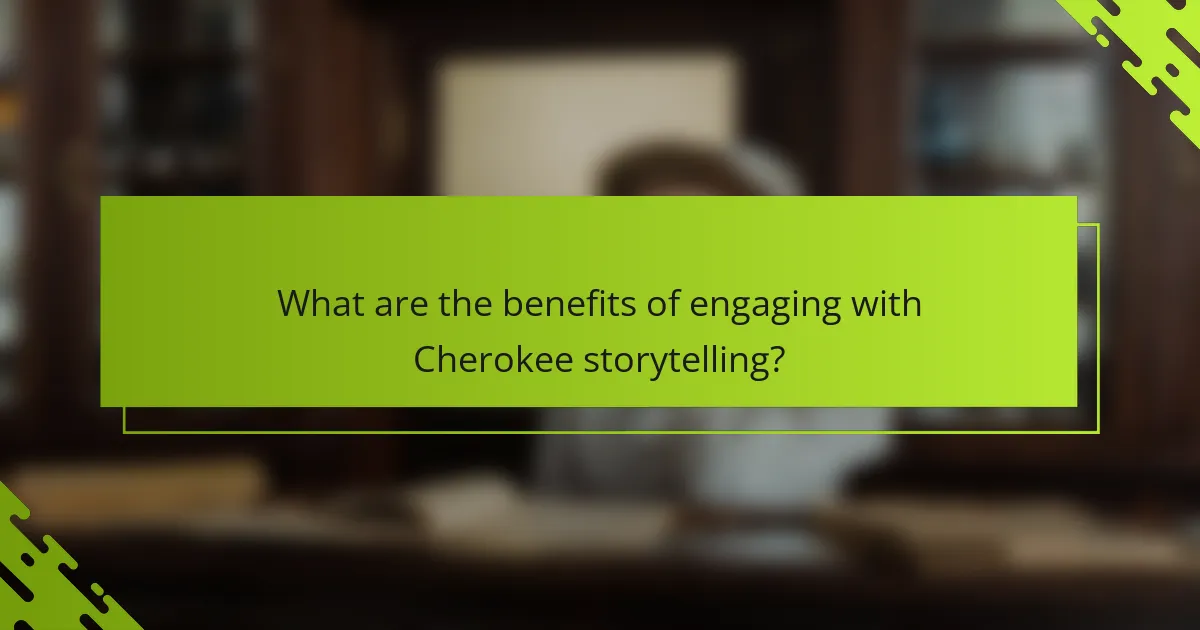
What are the benefits of engaging with Cherokee storytelling?
Engaging with Cherokee storytelling offers cultural preservation, community bonding, and educational enrichment. It fosters an understanding of Cherokee values and history, enhancing cultural identity. Storytelling techniques promote creativity and critical thinking in participants. Additionally, it strengthens intergenerational connections, ensuring traditions are passed down effectively.
How does storytelling foster cultural identity and pride?
Cherokee storytelling fosters cultural identity and pride by preserving traditions, values, and history. Through oral narratives, the Cherokee connect generations, reinforcing community bonds and shared heritage. Storytelling techniques, such as the use of metaphors and vivid imagery, enhance cultural transmission. Preservation efforts, including community workshops and digital archives, ensure future generations maintain these vital cultural expressions.
What impact does storytelling have on community cohesion?
Storytelling significantly enhances community cohesion by fostering shared values and cultural identity. Through Cherokee storytelling, individuals connect with their heritage, which strengthens social bonds. Techniques such as oral traditions and narrative structures promote engagement and understanding among community members. Preservation efforts ensure these stories remain vibrant, further supporting collective identity and unity.
Which lessons can be learned from Cherokee stories?
Cherokee stories impart valuable lessons about resilience, community, and the interconnectedness of nature. They emphasize moral teachings, cultural identity, and the importance of preserving traditions. These narratives foster a sense of belonging and encourage respect for the environment and each other. Through storytelling, Cherokee heritage is preserved and passed down, ensuring that future generations understand their roots and values.
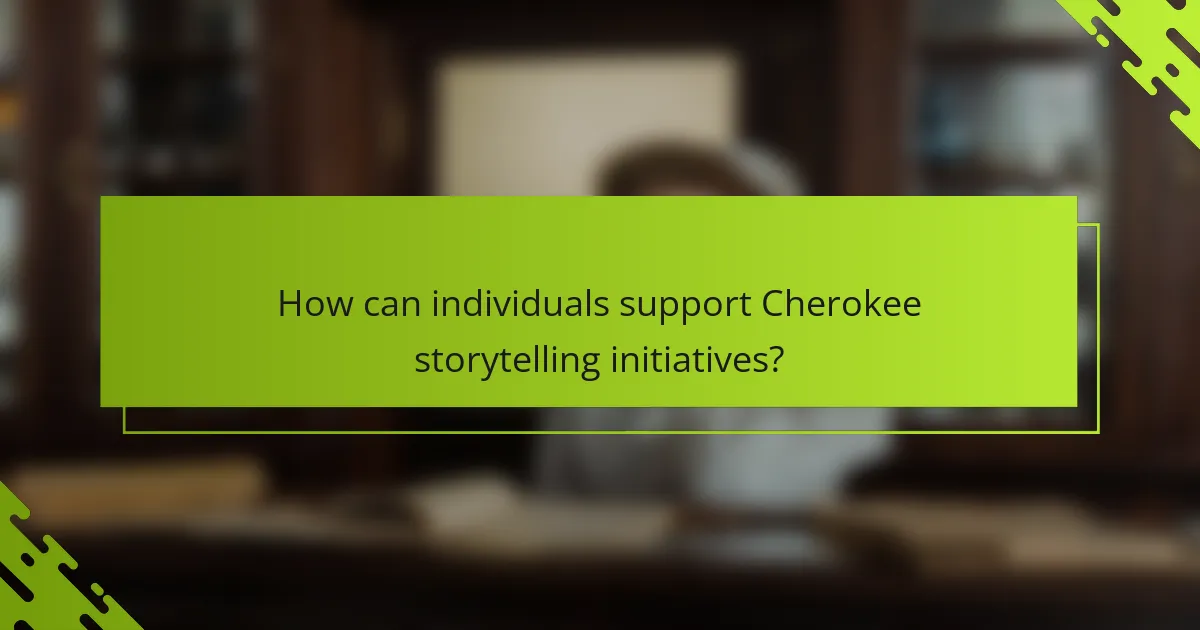
How can individuals support Cherokee storytelling initiatives?
Individuals can support Cherokee storytelling initiatives by participating in community events, sharing stories, and promoting cultural education. Engaging with local Cherokee tribes fosters appreciation for their heritage. Donations to organizations focused on storytelling preservation also help sustain these initiatives. Moreover, advocating for the inclusion of Cherokee narratives in educational curricula enhances visibility and respect for their traditions.
What are effective ways to participate in storytelling events?
Participating in Cherokee storytelling events effectively involves engaging with the community, understanding the cultural significance, and practicing storytelling techniques. Attend local gatherings to connect with storytellers and learn traditional narratives.
Practice storytelling by incorporating personal experiences and emotions, which resonate with audiences. Use visual aids, such as props or traditional attire, to enhance storytelling. Respect the heritage by acknowledging the origins of the stories and the storytellers.
Finally, collaborate with local organizations focused on preservation efforts to promote and sustain Cherokee storytelling traditions. This involvement not only enriches personal skills but also supports cultural heritage.
How can one contribute to educational programs focused on storytelling?
Contributing to educational programs focused on Cherokee storytelling involves several key actions. Support local initiatives that promote storytelling through workshops and events. Volunteer to share your skills in storytelling, helping to mentor younger generations. Donate resources such as books or materials that highlight Cherokee culture and history. Collaborate with schools to integrate storytelling into their curricula, emphasizing its significance in preserving heritage. Engage in community events that celebrate storytelling, fostering a deeper appreciation for Cherokee traditions.
What common mistakes should be avoided when sharing Cherokee stories?
To effectively share Cherokee stories, avoid misrepresenting cultural elements, oversimplifying narratives, and neglecting oral traditions. Respecting the authenticity of the stories is crucial.
1. Misrepresenting cultural elements can lead to misunderstandings. Ensure accurate portrayal of symbols and meanings.
2. Oversimplifying narratives strips away depth. Preserve the intricate layers of storytelling that reflect Cherokee values.
3. Neglecting oral traditions undermines authenticity. Engage with elders and community members to capture the true essence of stories.
4. Ignoring context can distort the message. Provide background information to enhance understanding for listeners unfamiliar with Cherokee culture.
What best practices can enhance storytelling experiences?
Incorporating best practices enhances storytelling experiences by fostering engagement and connection. Authenticity in narratives strengthens cultural ties, while interactive elements invite audience participation. Utilizing vivid imagery and sensory details captivates listeners, making stories memorable. Additionally, preserving traditional techniques ensures the authenticity of Cherokee storytelling, enriching the experience with cultural depth.
